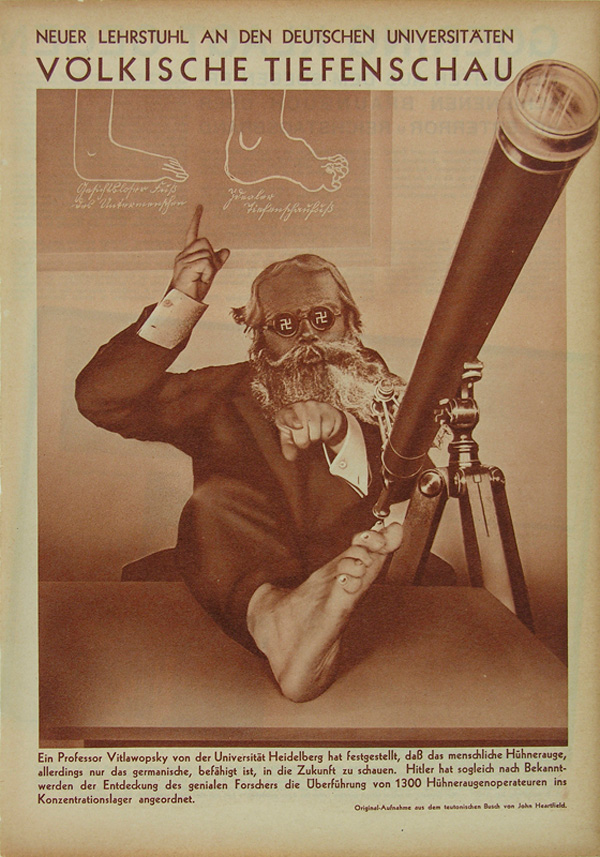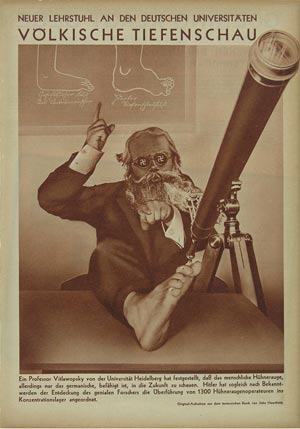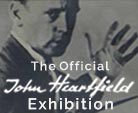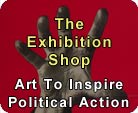Fake Nazi Science Same As Climate Scientists? Heartfield Collage Exposing Nazi University Theories Exposes Climate Deniers.
<< FAMOUS POLITICAL ART | HEARTFIELD ART FOR THE AIZ
Neuer Lehrstuhl an den Deutschen Universitäten(New Chair At German Universities)

New Chair to the German Universities


Appeared:
AIZ
(Arbeiter–Illustrierte–Zeitung)
August 31, 1933
Prague, Czechoslovakia
Share Your Reaction To This Art
Visiting Scholar’s Commentary
When Science Is Fake
By John J Heartfield
Heartfield mocks fake nazi science finding that only an Aryan’s corn has a “profound view” with the ability to “see the future.”
A translation of the text (see below) in the photomontage is a satiric critique of the university finding that only corns on pure German feet have fortune-telling ability.
Many academics were willing to go along with the Nazis after they gained power. Hitler’s asserted that human history was a biologically determined struggle between races. The Aryan was inherently superior. In 1931, The SS was empowered to conduct racial research. Völkisch had racial, national, and anti-Semitic connotations.
A loose translation of the German text in this montage reads:
NEW CHAIR AT GERMAN UNIVERSITIES
A RESEARCH OF THE PEOPLE
“A Professor Vitlawopsky of the University of Heidelberg has found that the menschliche (human) corn, however, is the only German corn empowered to look into the future. After the announcement of the brilliant researcher, Hitler immediately transferred 1300 corn operators (podiatrists) into concentration camps.”
“Original photograph from the Teutonic bush by John Heartfield” is Heartfield’s unusual credit.
The exhibition is grateful to visiting scholar Andrea Hofmann. Please enjoy her detailed commentary on this photo montage masterpiece. Ms. Hofmann also provides insightful historical context to add to the enjoyment of Heartfield’s work of political art.

A COMMENTARY ON HEARTFIELD’S POLITICAL ART MASTERPIECE
New Chair At German Universities
(Neuer Lehrstuhl an Deutschen Universitäten)
Written by Andrea Hofmann
John Heartfield had fled to Prague in April 1933, after a narrow escape from an SS assassination squad in Berlin. He must have felt terribly rattled. Yet, he fought back with another brilliant montage that is full of surprises.
In New Chair At German Universities, he highlights the arrogance and smug complacency of people in powerful positions, upends their overblown self-perception, and mocks their views. As the famous cartoonist David Low once pointed out, power-seekers do not like being exposed as idiots.
Heartfield admired Low. He always got the Evening Standard while he lived in exile in England because he looked forward to Low’s next caricature. Like Heartfield, Low ended up on the Gestapo death list.
Heartfield shared Low’s view that ridicule is the best antidote to tyranny. In this montage, he went for the brains that supplied the theoretical concepts of Nazi terror. He mocked German academics and universities.
Many of them eagerly embraced anti-Semitic, nationalistic and racist ideas once the Nazis came to power.
Others had paved the way for the rise of jingoism, intolerance, marginalization, and hate for years. They had made them socially acceptable and lent them the touch of respectability. In effect, they had undermined democracy.
Mocking the think tank, Heartfield offered instant comic relief. It was his way of lending visual support to people at risk who couldn’t leave the country and had to pay dearly for the growing madness all around them.
Setting The Scene
University professors were respected members of society. They were regarded as the intellectual elite. They had status, influenced political thinking, developed theoretical concepts and trained future decision-makers.
Heartfield undermines this image and diverts us with a clearly staged setting of a university classroom to appeal to our imagination and amusement.
A freakish professor presenting one bare foot on a table was unheard of decadence. One glance at this kind of academia deconstructs it as pompous, incompetent and non-scientific.
It also alludes to the popular German folk song “Show your feet, show your shoes” which celebrates female working-class culture, work ethics and competence.
The Telescope: Not Just A Phallic Symbol
One of the prominent elements in this montage is a Keplerian telescope. This could be a dig at the fact that Nazis promoted experimental physics based on Copernicus, Kepler, and Newton. They opposed theoretical physics based on Albert Einstein’s theories.
The Nazis despised the Jewish scientist Einstein. They hated Einstein for various reasons. One of them was that he had signed the “Urgent Call for Unity” like Käthe Kollwitz, Mary Saran, Minna Specht, Emil Gumbel, and many others. This was an appeal to bridge the divide between the SPD and KPD to prevent the Nazis from winning the election.
Another reason was that Einstein taught at the Marxist School for Workers (MASCH). This is where he gave a lecture titled: “What Workers Need To Know About The Theory Of Relativity.” Heartfield would probably have been aware of that. He taught there, too.
The MASCH was a groundbreaking education project initiated by the KPD around 1925. It was well-attended and offered a wide range of topics. Teachers and the audience came from all walks of society. The common factor that united them was their determined opposition to Nazism. Teachers worked for free. People like Albert Einstein, the lawyer Felix Halle, Irma Meidner, Willi Münzenberg, John Heartfield, and the author Anna Seghers were part of the Berlin Masch team.
Also, Heartfield’s professor resembles Hanns Hörbiger. Serious academics considered Hörbiger as the incarnation of pseudo-science. Hitler, Himmler and H. S. Chamberlain, all prime advocates of Aryan supremacy, promoted Hörbiger’s theory as an alternative to Albert Einstein’s Theory of Relativity. Hörbiger’s World Ice Theory was marketed along with a soppy story about his telescope. So, the telescope might also be a reference to him.
Poking Fun At Fake Facts
The caption of this montage reads: “A professor Vitlawopsky of Heidelberg University found out that the human corn, but only the Germanic one, can look into the future. As soon as Hitler learned of the discovery of the brilliant researcher, he ordered the transference of 1300 corn surgeons to concentration camps.”
Though the caption is funny, the headline leaves no doubt about the seriousness of the issue. It reads: New Professorship At German Universities – Nationalist Profundity.
Heartfield signed his work: Original photo taken in the Teutonic bush by John Heartfield.
Evidently, this piece is a montage, not an authentic photo. In a flash, Heartfield makes fun of fake fact photos journalism.
Deconstructing The Objectivity Myth Of Nazi Science
Science’s reputation rests on its claim of objectivity. Scientific findings often function as societal guidelines. The higher the reputation of the institution or person who puts forward a theory, the more credit it will be given. Ergo, Nazis wanted the backing of all the major think tanks as fast as possible. This way they wanted to eliminate potential opposition.
Conformity was enforced through the Law for the Re-Establishment of the Professional Civil Service. It guaranteed that civil servants who didn’t fit the bill could be dismissed for being politically unreliable. It also implemented racial criteria for academic posts at universities. This meant most Jewish teachers were expelled immediately.
Ruining academic careers and lives was neither an accident nor bureaucratic ineptitude. It was fully intended. It was a warning to everyone what would happen to them if they didn’t comply.
It also opened up new career chances for opportunists and hardcore Nazi supporters. These could then spy on their colleagues, denounce them and enforce the Nazi party line. A huge number of academics lost their job.
Heartfield cleverly visualized the intrinsic Nazification of academic teaching showing us a pair of sunglasses with inverted swastikas. As onlookers, we see the professor outwardly adorned with a symbol of honesty and peace. The professor, however, would perceive the world tinted by symbols of Nazi ideology. As so often with Heartfield, the devil is in the detail.
Why Sunglasses?
The use of Keplerian telescopes requires the use of light filters when watching bright objects. This would explain the sunglasses. If we assume that the imprint on the professor’s sunglasses is indicative of his observations, we might take into consideration that he is using a Keplerian telescope. This produces inverted images. Ergo, the professor’s universe is studded with Nazi symbols.
Hinting at astronomy and telescopes might also be a dig at covert military training. Keplerian telescopes have finder scopes with reticles. Teaching their use is excellent training for spotting military targets. Mastery of telescopes helps using weapons such as mortars and anti-tank guns. It also trains the mastery of night-vision techniques. These come in handy during blackouts and air raids. And, being able to interpret stars can be useful on ships.
The military angle is also suggested by the professor’s gesture. He points directly at us viewers.
The Finger Symbolism
The professor points his finger at us. Pointing a finger at someone is an act of aggression. Being pointed at makes us feel singled out and uncomfortable. We assume something is expected of us. This creates an urge to react. Either we comply or we resist. Many people know it as a classroom reflex. It’s a gesture often employed by teachers. Consequently, it conjures up hierarchical structures in no time.
The pointing finger was one of the chief recurring motifs in enlisting posters in WWI. Many countries used it. In fact, it has been used so often and effectively that it has become a visual symbol of war and military recruiting campaigns to this day.
The renowned British cartoonist and illustrator Alfred Leete was probably the first to use the pointing finger as a psychological hook. He designed the renowned recruitment poster in which the British war minister Lord Kitchener points straight at us and tells us to join up.
The popular American illustrator, Montgomery Flagg, used it, too. He designed the famous Uncle Sam poster with the slogan: “I Want You For The U.S. Army Enlist Now.”
Feet
Heartfield uses a finger also as a prompt to draw our attention to specific details of the montage. Heartfield’s professor is pointing at the drawing of some odd feet on the board behind him. This makes us pay closer attention to the drawing and unveils the professor’s belief-system.
The caption reads from left to right: “faceless foot of a subhuman” juxtaposed to “ideal profound foot.”
Note the ideal foot sports corns, just like the professor’s foot.
Hitler and his followers thought that human history was a biologically determined struggle between different races. They also believed that the Aryan race was the most superior. Ultimately they claimed that non-Aryans were subhuman.
With the dilettante drawings, Heartfield ridicules the idea of biological inferiority. He debunks it as unfounded and utterly absurd. Mocking it, he shows it up as an insult to our intelligence. All it takes Heartfield to deconstruct Nazi ideology is a couple of silly drawings on a school board with satirical comments. By the way, the political cartoonist Bert Thomas also used the ”Nordic corn” in one of his cartoons to poke fun at Nazis in 1935. Artists around the globe inspired each other in their way of standing up to Nazis.
Brainteasers: Keeping People Motivated
Heartfield spiced up his visual mockery with puns. Puns are a witty way to convey messages. They are riddles. Solving riddles makes us feel clever. This boosts our ego and makes us feel good about ourselves. When puns make us smile it releases stress.
Today we know that learning is connected to the reward system in our brain. The bigger the surprise element of the reward, the more dopamine is released into our system. Being human, we want more. Heartfield’s montages were definitely something to look forward to.
If we like the underlying message of a pun, we tend to bond with the person or product that came up with it. This is why puns are often used in advertisement, including political campaigns. They are also used in jokes.
The German word “Hühnerauge” means corn and “chicken’s eye.”
Eyes spot and identify things. If we look someone in the eye we assume we can read her or his thoughts and character.
What did the chiropodists see? Why would this knowledge pose a threat?
Changing Perspective
What do we see if we play chiropodist? Yin Yang symbols on the professor’s toes. This might be a reference to China.
It could have been a dig at the militarization of China with German aid. Crucial for the Sino-German cooperation was colonel general von Seeckt who was a military adviser to Chiang Kai-shek. On the other hand, in 1933, the Chinese communists were leading a fierce guerilla war. That might have given the viewers ideas.
Historical Context
The Nazis didn’t have a big power base before the early 1930s. In 1928 they had only 12 seats in the Reichstag. In 1932 they had 230! They were the largest party. They gained power fast. But, even in the last free election, in 1933, they didn’t achieve the majority of the total vote. They polled 43.9 percent.
So, the Nazis needed to justify their claim to power and supremacy. In order to do so, they promoted several key dogmas. One of them was the supposed “superiority of the Aryan race.” Needless to say, they claimed to belong to it. Another one was the “glorification of their definition of a healthy body.”
In order to assert Nazi power and uphold it, people had to become firmly convinced of their agenda. Therefore, alternative information and educational options were eliminated. One of these options was the MASCH.
Hierarchical structures were established swiftly to bring people in line and keep them there. The hierarchical re-organization was flanked by respective theories about superiority and inferiority. They served as excuses for speedy cleansing campaigns and fast-tracked the replacement of opponents with Nazi loyalists.
One of the institutions the Nazis could count on to oblige from the very beginning was Heidelberg University.
Heidelberg
Today we think of Heidelberg and its university as a quaint place. So why did Heartfield expressly mention Heidelberg?
In Heartfield’s time, Heidelberg University was a high-ranking university. It was also a hotspot of far-right professors and notorious for its right-wing students. It was even the center of a huge academic scandal that went on for years before the Nazis came to power.
The mathematics professor and statistician Emil Julius Gumbel started teaching at Heidelberg University in 1923. Far from being stuffy, Gumbel wrote powerful articles about political murders and illicit rearmament. He was a member of the German Human Rights League and publically criticized the politicized justice system of the Weimar Republic. He was also an outspoken pacifist.
Many of his colleagues were scandalized. They considered him an embarrassment and a misfit. Right-wing students protested against Gumbel on a regular basis. In 1932, the Ministry of Education and Cultural Affairs in Karlsruhe revoked Gumbel’s teaching license at the request of Heidelberg University. The university speedily sacked Gumbel from the faculty.
Mind, Gumbel was not dismissed for incompetence but because he was insubordinate. He refused to give in to bullying, humiliation, and threats. He just wouldn’t shut up about what he saw as a threat to democracy: Covering up crime.
Naturally, Gumbel’s dismissal encouraged right-wing pressure groups. It validated their agenda and their bullying tactics. It propelled Nazi ideology and made it socially even more acceptable.
Heartfield knew of Gumbel. Some of Gumbel’s research had been published by Malik-Verlag, the publishing house where Heartfield’s brother, Wieland Herzfelde, ran the business and Heartfield supplied groundbreaking graphic designs. So, it is quite possible Heartfield and Gumbel have met. In his September 1933 montage, “The Bedbug As Vermin Exterminator,” Heartfield even referred to Gumbel. This montage points out that the citizenship of 33 Germans had been revoked.
But the witty dig at Heidelberg contained even more political dynamite. One of Heartfield’s archenemies had studied at Heidelberg University: Joseph Goebbels. It would have given Heartfield immense satisfaction to ridicule Goebbels’ (academic) credentials and thereby Goebbels’ credibility. After all, Goebbels was the minister of propaganda. This made him one of the most powerful and dangerous men in Germany.

